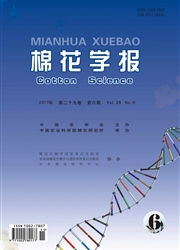

 中文摘要:
中文摘要:
以棉花高毒力大丽轮枝菌(Verticillium dahliae Kleb.)菌株VDG1和低毒力大丽轮枝菌菌株VDG2基因组测序数据为基础,通过比较基因组学和分泌蛋白预测发现VDG1中1个特异分泌蛋白,将其命名为HSSP。通过PEG介导的原生质体转化方法获得了该基因的敲除突变株ΔHSSP,并以木糖、淀粉、纤维素、果胶、木聚糖和半乳糖为底物模拟分析了其降解细胞壁组分的能力,发现该突变体的果胶酶、木聚糖酶和半乳糖酶活力较野生型显著降低;通过测定菌丝产量和孢子产量,发现HSSP基因对菌丝和孢子的形成均有重要作用;通过定量蘸根接种法在感病棉种军棉1号上测定致病力,发现HSSP基因敲除突变体的致病力与野生型相比明显减弱。上述结果说明HSSP作为高毒力大丽轮枝菌菌株VDG1中1个特异的分泌蛋白在对寄主棉花的致病过程中发挥了重要作用。
 英文摘要:
英文摘要:
The fungal Verticillium genus includes some pathogens that cause wilt disease in plants. Comparative genomic analysis and protein prediction of the highly virulent Verticillium dahliae strain VDG1 and the non-pathogenic V. dahliae strain VDG2 identified a VDG1-specific secretion protein, HSSP. HSSP was replaced in VDG1 by the hygromycin gene via PEG-mediated transformation. The Δhssp mutant was grown on Czapek agar with diverse carbon sources including xylose, starch, cellulose, pectin, xylan, and galactose to evaluate to plant cell wall degradation. Pectinase, xylanase, and galactosidase activities were significantly lower in the Δhssp mutant when compared with that of VDG1, respectively. Mycelia and spore yield were lower in the Δhssp mutant as well. Importantly, the Δhssp mutant was considerably less pathogenic than VDG1 when tested on the cotton plant variety Junmian 1. We conclude that HSSP is a VDG1-specific secretion protein that plays an important role in VDG1 pathogenicity.
 同期刊论文项目
同期刊论文项目
 同项目期刊论文
同项目期刊论文
 期刊信息
期刊信息
